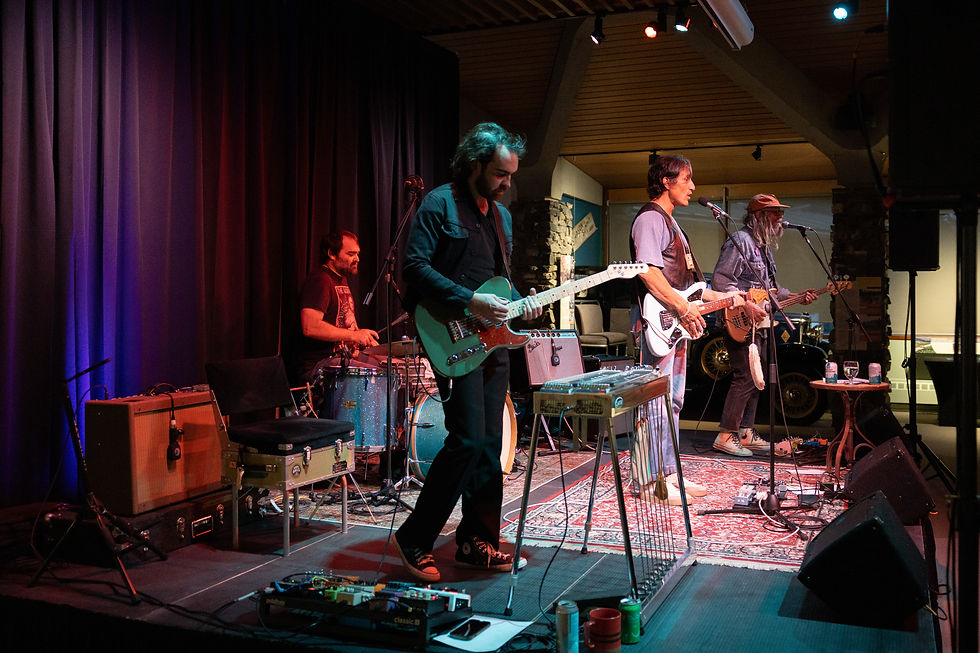Dispatch from the Moore Home: The Living Room
- Jun 18, 2020
- 3 min read
By Amie Lalonde, Collections Cataloguer
Welcome back to the Moore home! The living room is the most quintessential turn-of-the-century-cabin room imaginable. Lining the walls are taxidermy mounts of animals that Philip and Pearl shot, with one exception–a magnificent bison head that they won in a raffle. Because of these heads, working in this main space of the house is more than a little eerie. At all times there are over a dozen eyes on you and some of them really do seem to follow you around.


This room also really showcases the Moore’s relationship with local (and further afield) Indigenous groups through the stunning beadwork hung on the walls and the banister. Philip and Pearl's relationship with the Stoney Nakoda stemmed from Pearl's childhood and the Brewster relationship with several Stoney Nakoda families and individuals, most notably William Twin who accompanied her brothers Bill and Jim on their first guiding excursion. This long standing relationship resulted in both her and Philip Moore being adopted by the Stoney Nakoda as Princess and Chief in 1948. In a letter to her mother, Catharine Robb Whyte discussed the quiet ceremony, saying “I asked [Pearl] about being taken into the Stoneys but she couldn’t tell us much. They sing a song and say a prayer and sing God Save the King and she and Runt [Philip Moore] each got some present of clothing I think. She is now a princess… and Runt is a chief.” Of the beautiful beadwork around the room, one favourite of Pearl's seems to have been this vest (pictured below); there are multiple photographs of her wearing it in our Archives.

Pearl Moore and George Vaux X, [ca. 1930], Whyte Museum of the Canadian Rockies,
Moore Family fonds (V439/PA-235)

Vest (103.05.0001), Gift of Pearl Evelyn Moore, Banff, 1979.
Art by Carl Rungius above the piano and up the stairwell illustrates another important relationship that the Moore family had. Rungius, who first came to Banff in 1910 at the request of outfitter and guide Jimmy Simpson, was a renowned wildlife painter whose beautiful paintings and sketches of wildlife in situ are a valued part of the Whyte Museum's art collection today.

Pearl Moore, Philip Moore, Catharine Robb Whyte, Carl Rungius, Peter Whyte, and John Murray Gibbon at Ptarmigan Valley, 1939,Whyte Museum of the Canadian Rockies,
Peter and Catharine Whyte fonds (V683/III/A/15/PA-624)

Paintings by Carl Rungius over the piano. Counter-clockwise from left: Carl Clemens Moritz Rungius (1869 – 1959, American), Storm over Mountain View, c. 1920, oil on canvas, Whyte Museum of the Canadian Rockies, 17.5 x 26.5 cm, RuC.02.13; Evening on the Ram, 1937, oil on canvas, 21.5 x 26.5 cm, RuC.02.08; Bow Valley and Mount Bourgeau, c. 1935, oil on canvas, 39.5 x 49.0 cm, RuC.02.11; Mount Rundle, April, c. 1927, oil on canvas board, 21.5 x 26.5 com, RuC.02.07; Mountain Scene, Summer, c. 1949, oil on canvas, Whyte Museum of the Canadian Rockies, 22.0 x 27.0 cm, RuC.02.12. On top of the piano are stone and wood pipes and carved wooden animals: all Stoney Nakoda in origin.
An object that is significant to me personally is this incredibly plush sofa. A label beneath the centre cushion reveals it to have been made by a company based out of my hometown of Waterloo, Ontario! It makes me wonder if it was bought from a retailer nearby or if it was ordered by catalogue and shipped west by train.


Sofa (102.03.0048), Gift of Pearl Evelyn Moore, Banff, 1979.
With the bulk of the downstairs finished, it's time to turn our attention upwards! Next I will be taking you through my exploration of the Moore Home attic. Stay tuned!



Hej, om du vill tjäna pengar på byggandet måste du installera fotoplafond för att skapa en miljö där människor mår bra, är mer produktiva och vill stanna längre.